A ten-photo series, plus a different version of two of them.
This drake Gadwall was a little more tolerant of my approach in my pickup than most of the ducks I photographed two days ago at Bear River MBR. So with him I used a different strategy to anticipate his takeoff.
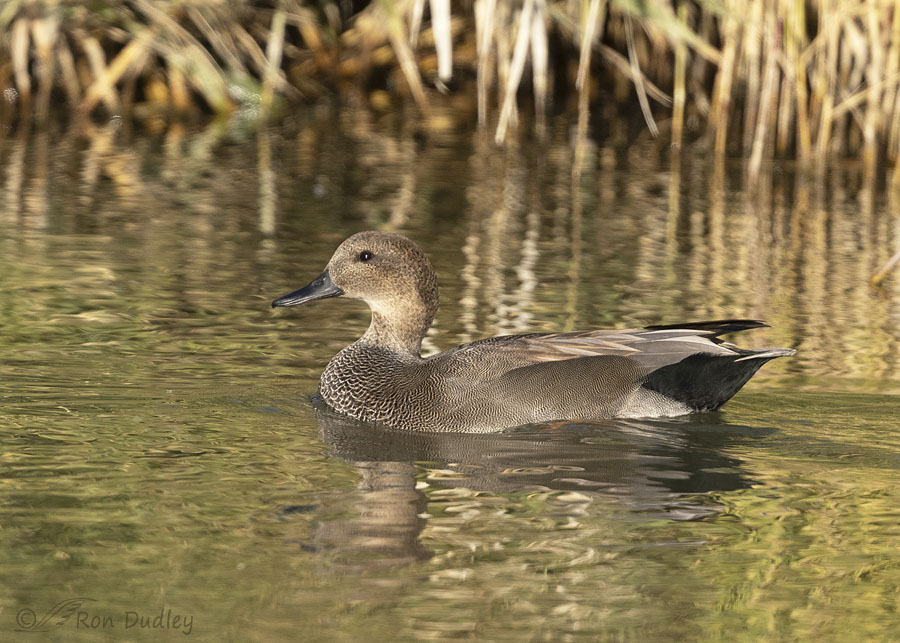
1/4000, f/5.6, ISO 800, Canon R5, Canon EF500mm f/4L IS II USM + 1.4 tc, not baited, set up or called in
I could tell he was nervous about my approach but he didn’t fly off at first so I got a few shots of him on the water. Besides, with him facing in this direction I figured he wouldn’t take off because the breeze was coming from my right and ducks, if given the chance, will usually take off into the breeze or wind.
But almost immediately after this photo was taken, he stopped swimming forward and turned around in the water to face the incoming breeze. That was my clue that he was probably going to take off, and soon.
I was right.
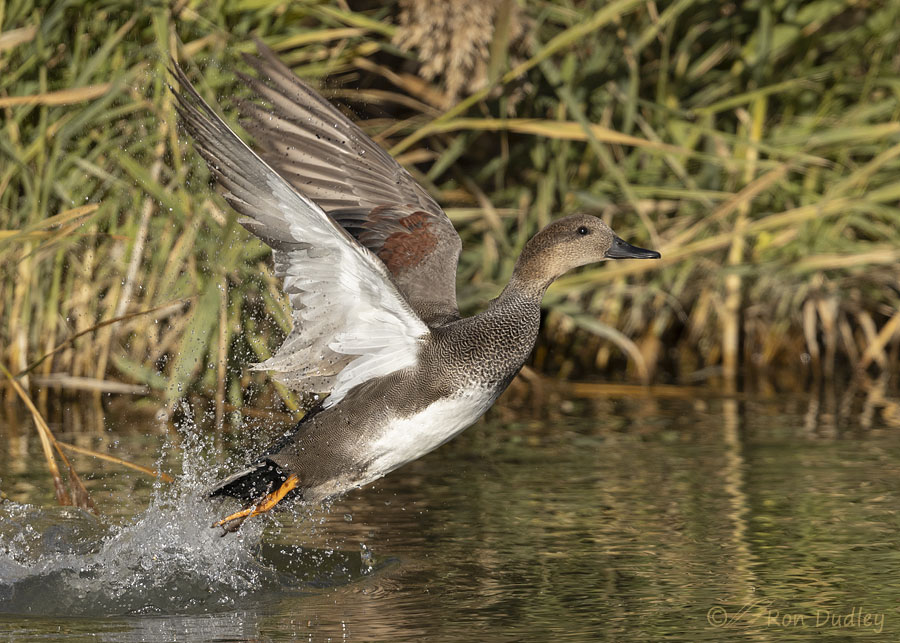
1/4000, f/5.6, ISO 800, Canon R5, Canon EF500mm f/4L IS II USM + 1.4 tc, not baited, set up or called in
Being able to anticipate his takeoff meant that the first shot in my burst captured him immediately after his feet left the water. Their takeoff is so fast I was pleased to catch him this early in the process.
Starting with this shot, all photos are presented in the order they were taken without any skips.
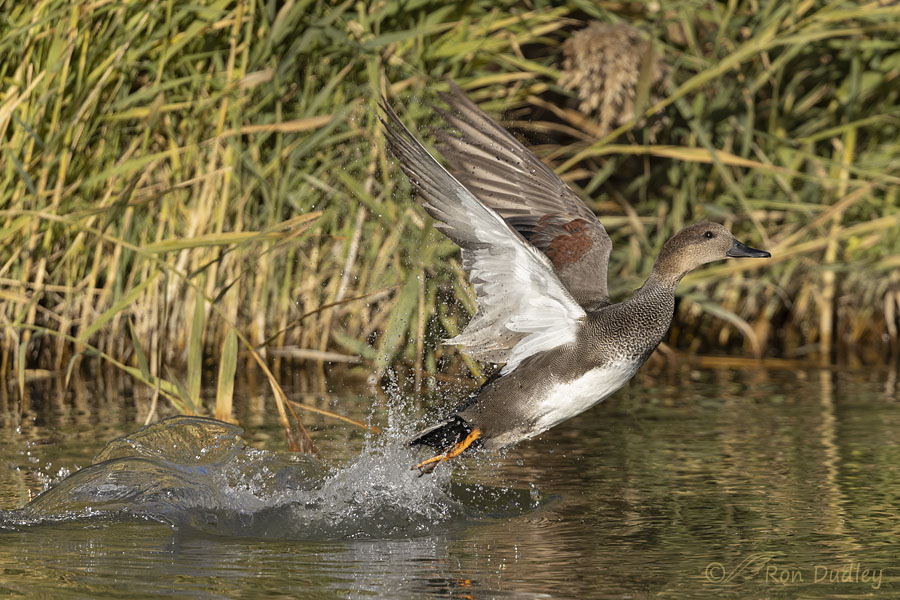
A different composition of the previous photo, just because I like to see the entire water splash behind the bird. It’s their webbed feet pushing back against the water slightly before this photo was taken that gives them a big part of the explosive acceleration that allows them to become airborne so quickly.
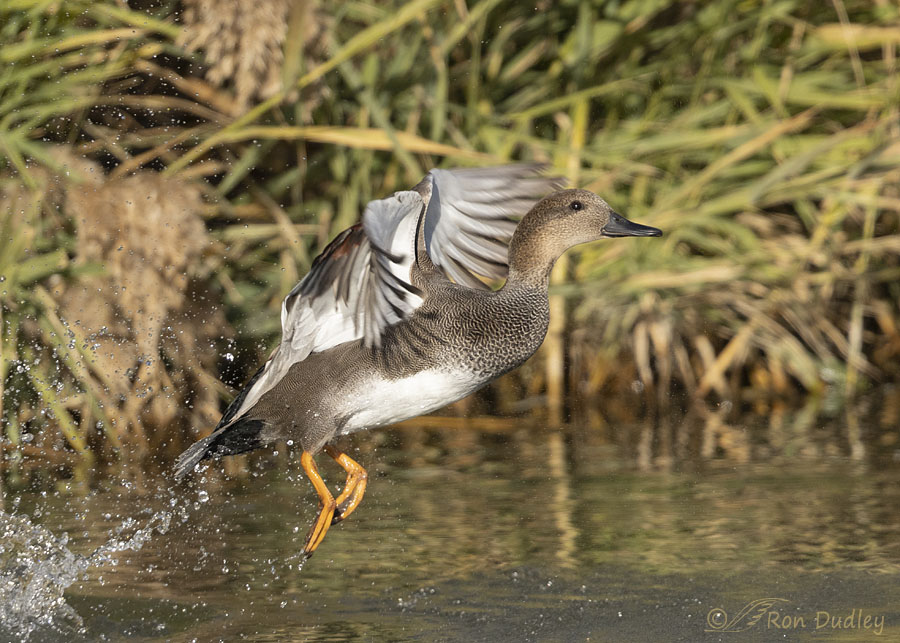
1/4000, f/5.6, ISO 800, Canon R5, Canon EF500mm f/4L IS II USM + 1.4 tc, not baited, set up or called in
I think of this wing position as their “crinkly-wing posture”.
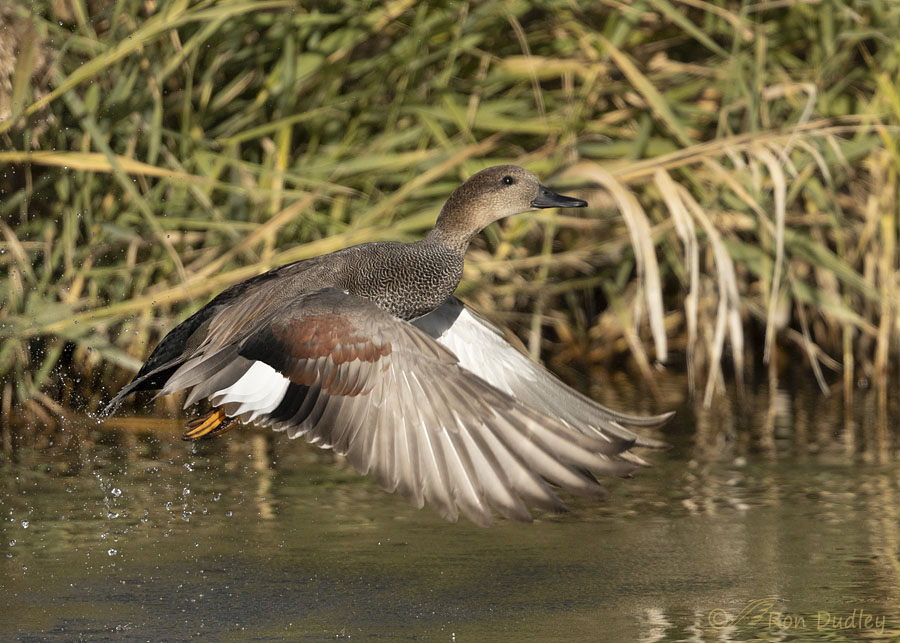
1/5000, f/5.6, ISO 800, Canon R5, Canon EF500mm f/4L IS II USM + 1.4 tc, not baited, set up or called in
One of my two favorite shots of the series.
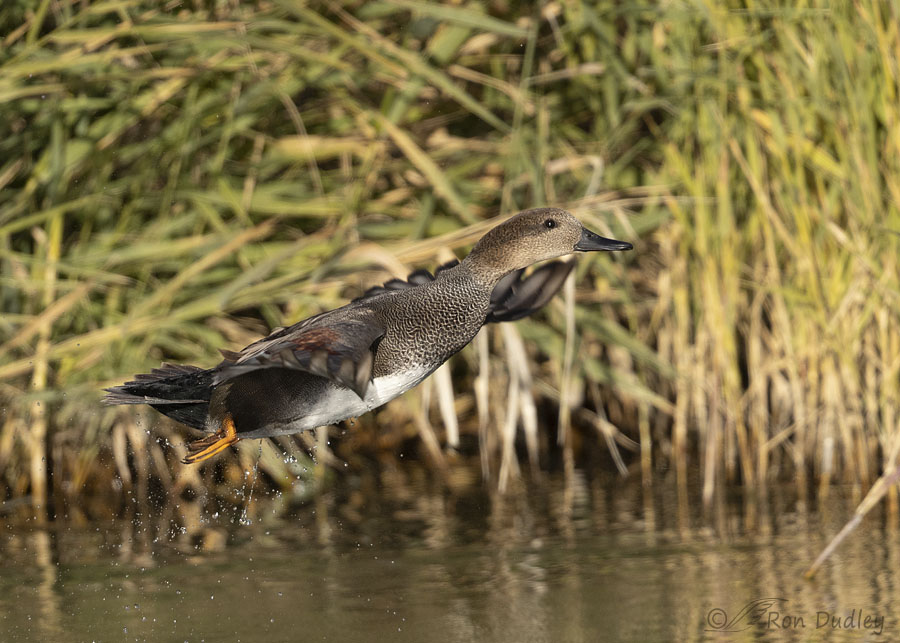
1/4000, f/5.6, ISO 800, Canon R5, Canon EF500mm f/4L IS II USM + 1.4 tc, not baited, set up or called in
A horizontal wing position. Maybe not the most photogenic posture but with flight, especially during takeoff, it comes with the territory.
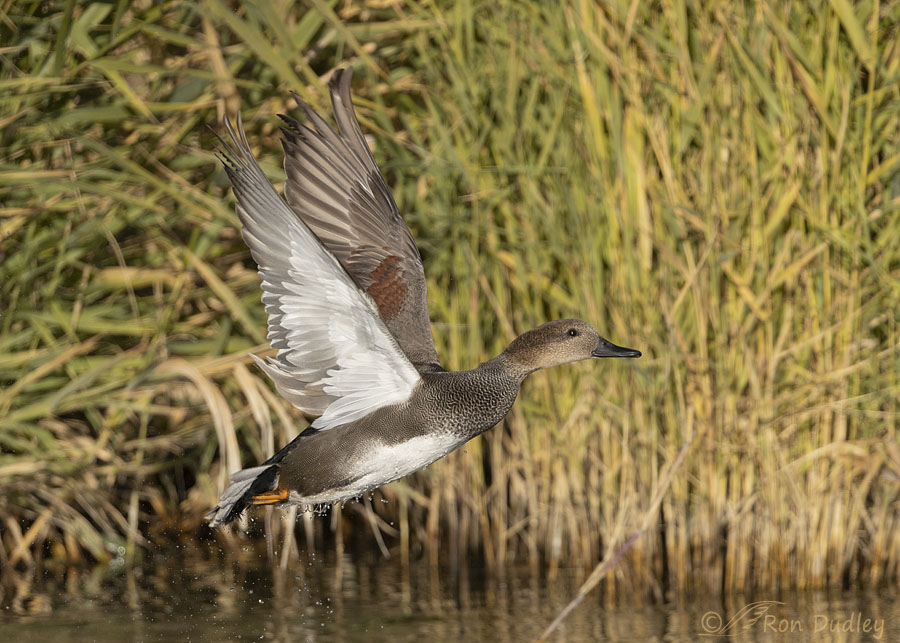
1/5000, f/5.6, ISO 800, Canon R5, Canon EF500mm f/4L IS II USM + 1.4 tc, not baited, set up or called in
While I was processing this photo I became curious about what I was seeing hanging down from his lower belly directly in front of his foot. It seemed a little unusual, and I wasn’t seeing the same thing in the previous photos, so I…
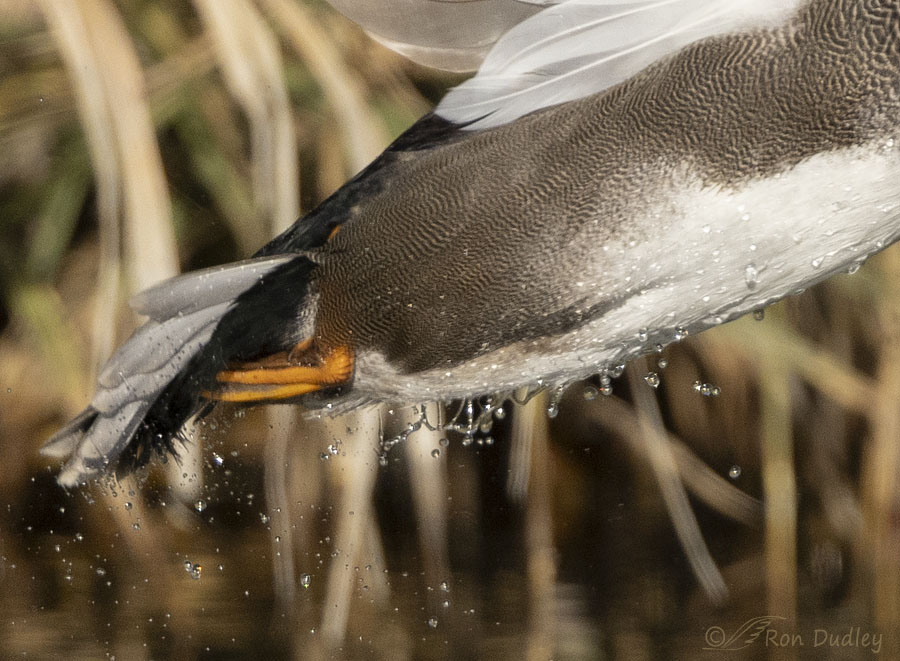
had to have a closer look. It’s just wet feathers hanging down with water drops coming off them. No big deal, but it satisfied my curiosity.
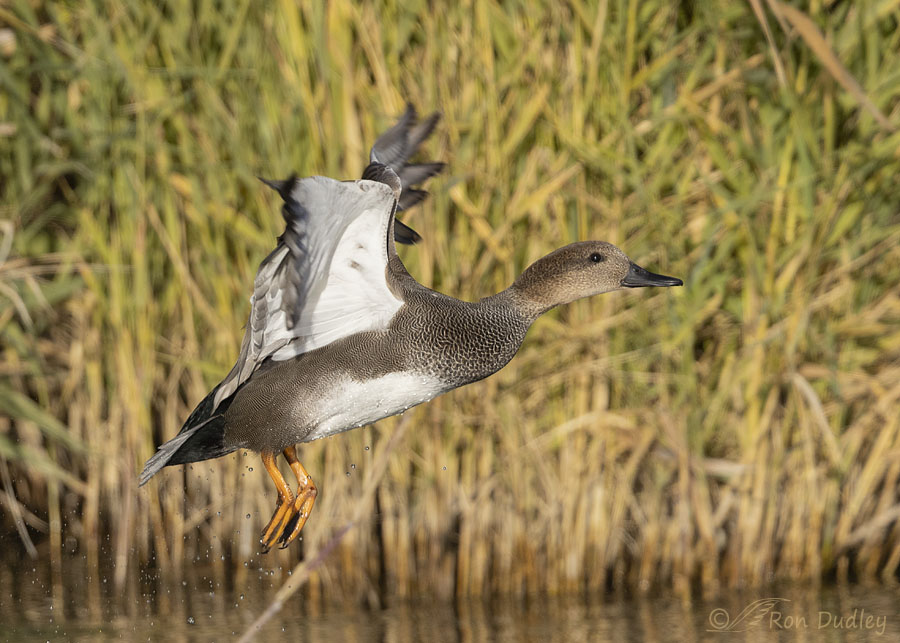
1/5000, f/5.6, ISO 800, Canon R5, Canon EF500mm f/4L IS II USM + 1.4 tc, not baited, set up or called in
Another crinkly-wing posture.
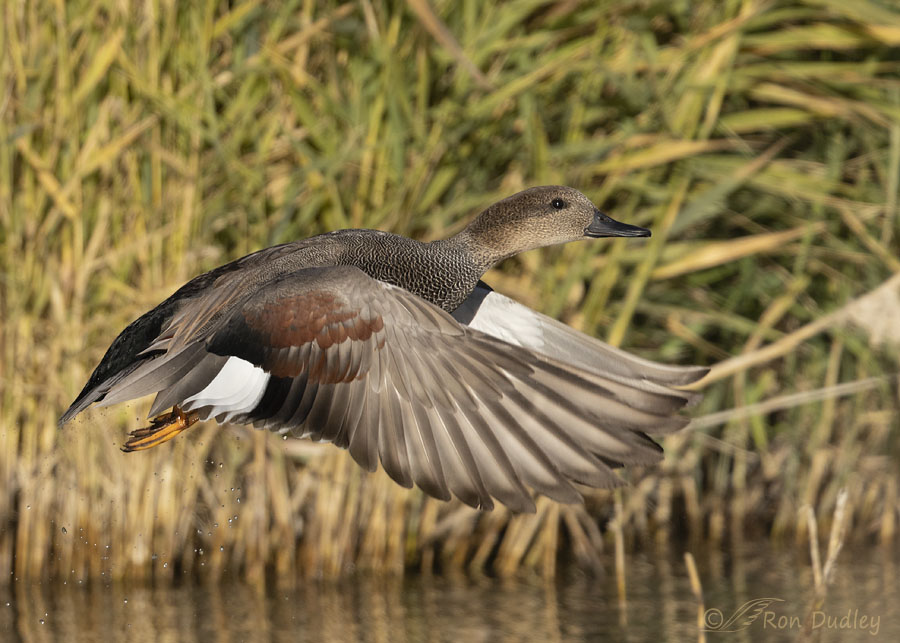
1/6400, f/5.6, ISO 800, Canon R5, Canon EF500mm f/4L IS II USM + 1.4 tc, not baited, set up or called in
This may be my favorite photo (of mine) of a Gadwall in flight of all time. It’s quite similar to photo #5 but this one is marginally sharper, so I like it best.
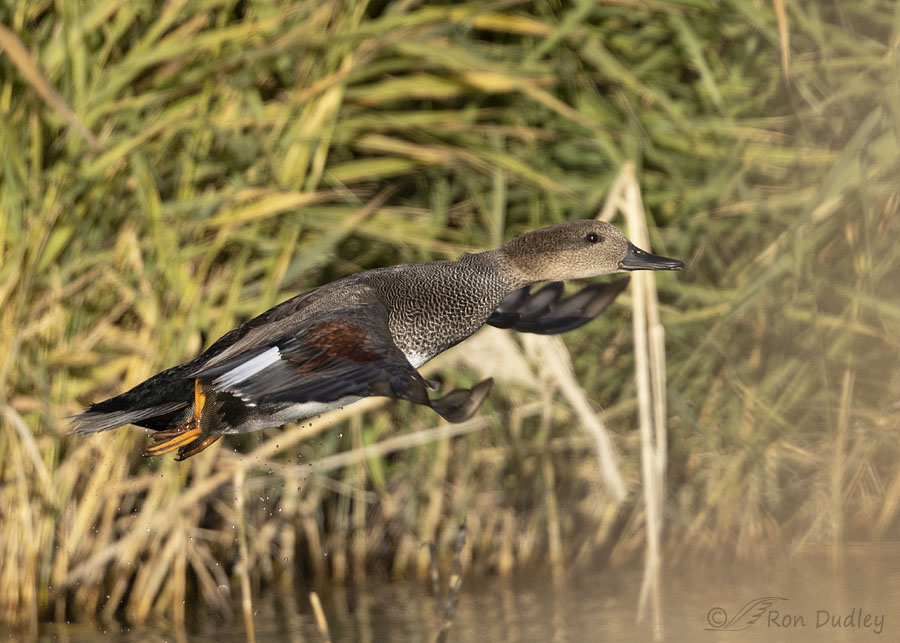
1/6400, f/5.6, ISO 800, Canon R5, Canon EF500mm f/4L IS II USM + 1.4 tc, not baited, set up or called in
My successful run of sharp (or sharp enough) photos is about to come to an end.
I was shooting through a ‘window’ of tall phrags on my side of the canal and in this shot we can see the hazy fuzziness on the right side of the frame that was caused by phrags in front of me that were about to come between me and the bird.
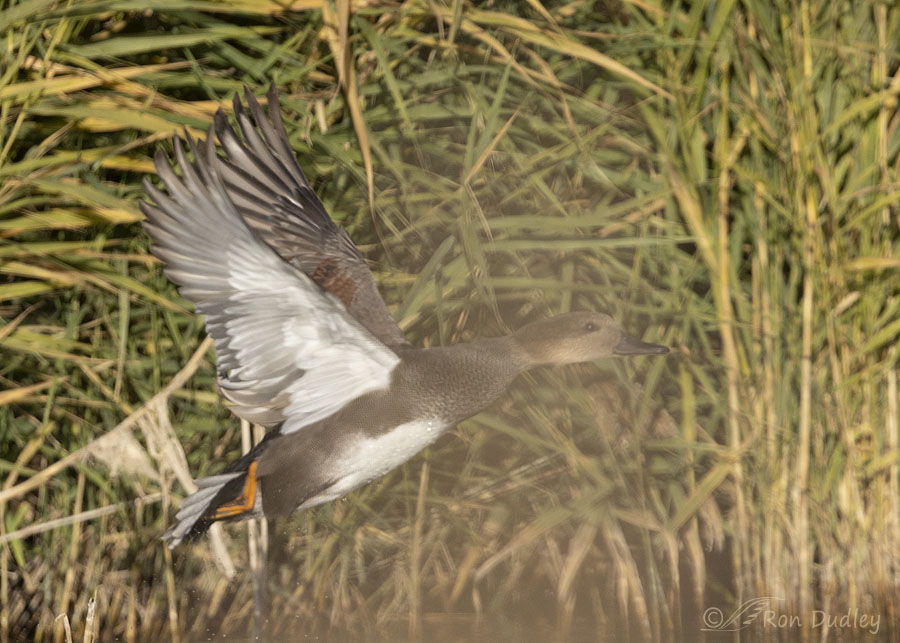
1/6400, f/5.6, ISO 800, Canon R5, Canon EF500mm f/4L IS II USM + 1.4 tc, not baited, set up or called in
In this shot I’m shooting through the phrags, thus all the haziness. The bird is still sharp, thanks to the Canon R5 for that, but the photo was ruined. After this shot, because of the foreground phrags, I completely lost focus on the bird.
Too bad, this last photo might have been one of my favorites of the series.
Ron


Gadwall take off flight series data shows shutter speed increasing from 1/4000 to 1/6400. Was it because you were using shutter priority with fixed ISO? I have always shot in manual with auto ISO and never gave much thought to the other modes. Have enjoyed your great photos over the years.
Dow, it was because I was shooting in aperture priority with fixed ISO. So as the duck flew through lighter backgrounds my SS shot up.
He’s a beaut! Love the shots with all the water play. Definitely a gift, Ron. Thank you.
Thanks very much, Marty.
Beautiful photos!
Thanks, April.
How very, very beautiful. How wonderful to have this explosive take off captured so that you/we can pore over it frame by frame. So often the common birds (though this is NOT common here) have a subtle beauty that repays closer examination. Thank you. And your experience, persistence and camera.
Thanks very much, EC.
Gadwalls are one of my favorite ducks. All too often they are overlooked as being very plain and not having flashy colors. The subtle patterns give and elegance and grace not as well matched by many ducks. Birds that are “plain” or “common” both are often largely ignored and as a result, people miss the subtle beauty or behaviors that can be found by more patient observation.
I agree with all you said, Dan.
Thanks for the photos. I think he is pretty and does have a nice rust color on part of his wings, This another nice group of photos.
Thank you, Trudy.
Team Photo #5 because of his head position. Your #1 does have better sharpness on the wings so I can appreciate why you enjoy it. Love ducks …. my mother raised mallards so we always had baby ducks around the house until they were too big and had to go outside.
Your #1 pick = photo #10
That’s pretty unusual, Kathleen. It isn’t every family that raises Mallards. Must have been fun for little kids.
Mallards and chickens
VBG! Wonderful series making a rather “plain” duck show it’s beautiful and powerful side during the takeoff – things one wouldn’t “see” notice if the action weren’t stopped.:) R5 is definitely serving you well with the full frame and tracking abilities….
“VBG!” always makes me think of Dick Harlow. With fondness.
Thanks, Judy.
You really have this takeoff skill set locked in. Great shots all. The Gadwalls are such plain looking ducks when just floating along, but in a take off they become far more attractive. Great job.
“You really have this takeoff skill set locked in.”
Thank you, Everett. I’m working on it. It doesn’t work every time but it’s improved my success rate dramatically.
What an exciting series of shots ! It tickles me that your knowledge
of the ducks’ behaviors ( like preference for taking off into the wind)
serves you so well in anticipating the upcoming behavior and
gaining a slight edge for a better “capture”……
Kris, missing shots I want so badly has given me strong motivation to learn their behaviors that signal imminent takeoff. It’s finally paying off. As you say, it’s only a “slight edge” but that’s usually all you need.
A great series!!!
So even before your “review” of “The American Buffalo” on PBS I was planning to watch it. I never miss a Ken Burns series. (And you’re so right about the voice of Peter Coyote.) We have about an hour left to watch, but it is so interesting, riveting, moving, and maddening. I just wanted to add my thumbs up to yours!
When I said “a great series” I was referring to your photos today. . .just to clarify
I’m so glad you’re watching “The American Buffalo”, Sue. And that you let me know you are.
Your reaction to it is pretty much identical to mine. I still think about some of the stuff in it daily, even a week later.
I mentioned that Peter Coyote’s voice strongly reminds me of Henry Fonda’s voice. I had never seen the old movie “Once Upon a Time in the West” so I started watching it last night. I’m not much of a fan of spaghetti westerns but I just had to see Henry Fonda as a dastardly villain. It seems so very incongruous…
Wow! I am amazed how you can track a duck takeoff with that huge lens. Enjoyed all the photos and the narrative.
Appreciate that you like the entire water splash (I do as well), but the angular dynamics and composition of photo #2 are perfect.
You are rightfully proud of Photo #10. It’s a gem.
Ducks. The amazing flying boats.
“I am amazed how you can track a duck takeoff with that huge lens.”
Thanks, Michael. It really helps with that to have the R5 because I’m shooting full frame (instead of cropped frame) with a huge file size so I have lots of room in the frame and can crop significantly and still have oodles of detail. That said, these photos aren’t cropped a whole lot.
This is one of those birds that seems ‘plain,’ until I take some time to explore all the intricate patterns and shades of color that your photos reveal. It’s a great series — including those drippy belly feathers!
Thanks very much, Shoreacres. I think the drakes are quite handsome, especially with their wings out and down as in photos #5 and #10.